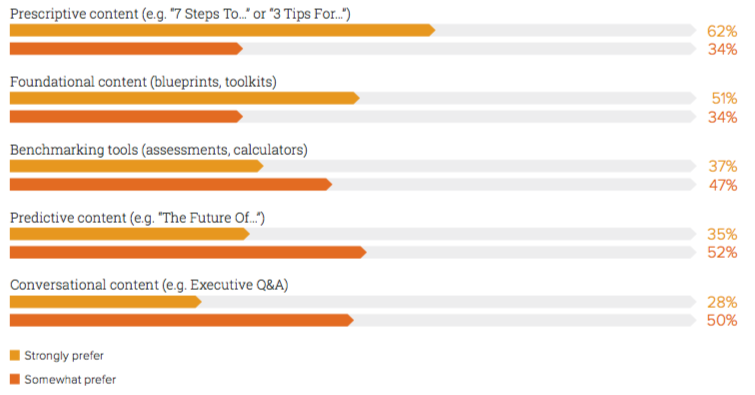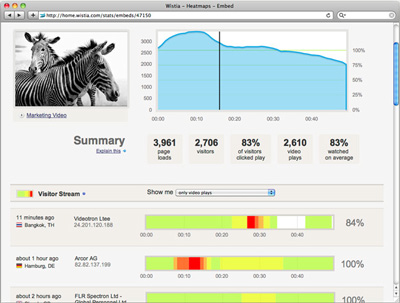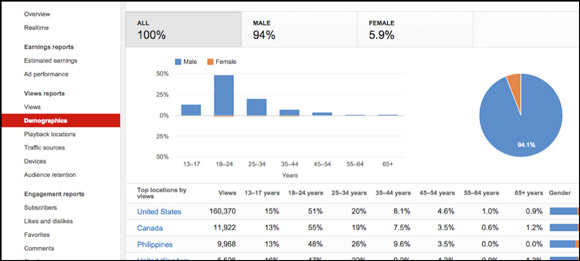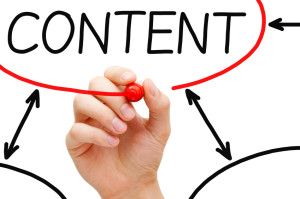by Glen Springer | Feb 15, 2018
B2B Content Preference Trend: “A typical firm with 100-500 employees, involves an average of 7 people in most buying decisions” (Gartner Group).
In today’s B2B marketplace, time-starved buyers are using digital content to research solutions for their current pains – 67% of the buyer’s journey is now done digitally (Sirius Decisions). So as a modern marketer, it’s critical to understand your B2B buyers’ journey and then to create educational and thought-leadership content around each buyer stage. Content is critical because 80% of business decision-makers prefer to get learn about new solutions from company articles versus a advertisements or cold callers (B2B PR Sense Blog).
So, B2B content preference tells us what types of content are B2B buyers looking for to learn about solutions? Understanding the answer to this question is key to sales success because 57% of B2B buyers have already made their short list for purchase decision before ever speaking to a sales person (CEB Global).
So as content marketing continue to increase in importance and becomes more competitive – 90% of B2B buyers say online content has a moderate to major effect on purchasing decisions (CMO Council) – and we move full-speed ahead in 2018, we wanted to look back at the trends of 2017 to gauge where we should concentrate our efforts according to the research performed by Demand Gen, in its 2017 Content Preferences Survey Report.
We sifted through all the data and pulled out our top 5 B2B content preference statistics for 2017-18 – we’ll keep it short because as the report states: 34% of buyers have less time to devote for reading and research on purchases than last year.
1. 78% say they prefer case studies because it allows them to benchmark themselves against their peers and study real-world examples of a potential solution.

2. 71% prefer content that’s easier to access – 62% want more benchmarking data 87% of buyers give more credence to industry influencer content.

3. Email remains the channel most buyers employ to share content, while LinkedIn remains the leading social network.
4. 97% of B2B buyers prefer prescriptive content that recommends a formulaic solution.
5. 95% of buyers said they are willing to share their name, company, and email in exchange for the following content types:
- white papers (76% said they will share information),
- E-books (63%), webinars (79%),
- case studies (57%)
- third-party/analyst reports (66%).
They’re less willing to register for asset types such as:
- podcasts (19%),
- video (19%)
- infographics (24%)

Summary
Content is the most effective way to educate buyers about your solution and ignite meaningful conversations. It is important to share relevant and educational material. And it is important to share that content consistently and at the right time. Great content organized in a way that creates a memorable experience keeps your buyers engaged and allows them to easily choose the solution that makes sense for them. Delivering content in a calculated and coordinated process allows you to educate and build trust with prospects and move them through the buyers’ journey and into your sales funnel at the same time. And the modern B2B buyer prefers receiving content digitally before engaging with a sales rep. Content can help sales reps sell faster because 63% of consumers need to hear company claims 3-5x before they actually believe it (Edelman Trust Barometer).
About Us
Gabriel Sales specializes in helping SMBs and Startups grow business with modern sales and marketing operations. Our team understands B2B content preference and can augment gaps in your existing sales and marketing operations or we can be leveraged for full service campaigns that include:
- Integrated Sales and Marketing Strategies
- Database Research and Targeting
- Automation and CRM Systems Best Practices
- Systems Implementation
- Inbound Lead Generation
- Outbound Lead Generation and Lead Scoring
- Sales Qualification
- Closing
To learn more about how we can help you grow your business (or decide if we are the right fit for you), we invite you to visit our page that details our integrated approach to sales and marketing outsourcing. Or feel free to contact us for free initial consultation and discovery session to see if our approach is the right fit to help you hit your revenue targets.
by Carol Springer | Nov 2, 2016
Digital marketers have an analytical issue when it comes to video performance on platforms like YouTube, Vimeo, or Wistia. How many times have you asked yourself this question – ”How many views means my video is successful?”
The “scorecard” that your video is rated on is the number of views. Unfortunately, doing an analysis on just “views” is not always the best way to track your brand’s progress on the goals you are trying to achieve. This is especially true if your goal to drive real sales opportunities’ into your closers pipe (which is our top priority as an outsourced sales and marketing company).
So instead of asking yourself the previous question, ask yourself – “Which KPIs should we be tracking to understand if our video campaign is successful moving deals into the pipe?”
Question #1: How Do I Identify My Primary Outsourced Sales Video Goals?
Marketers typically want video advertising campaigns to increase awareness about their product and influence online sales. While buyers no longer have a simple experience with your brand anymore thanks to product reviews, mobile engagements, social media, etc.—most marketers and salespeople agree their target audience fits into one of three categories: unfamiliar, on the fence, or ready to buy.
With each new campaign, it’s important to know where your audience lies in these three areas. Which of the three possible brand goals is your #1 priority?
Question #2: What are the KPIs for that marketing goal?
The next stage after identifying your goal is to take a closer look at the data that is being mined for each video.
Here is a breakdown of what KPI to analyze for each goal:
Awareness goal KPIs:
- Views
- Impressions
- Unique Users
Consideration goal KPIs:
- View-Through Rate
- Watch Time
Action Goal KPIs:
- Clicks
- Calls
- Signups
- Sales
Question #3: Where and How do I properly analyze my data for my videos?
 Now that you have identified your primary goals and your KPIs for those goals, you now need to identify the tools that you going to use to help you become more data-driven as a marketer.
Now that you have identified your primary goals and your KPIs for those goals, you now need to identify the tools that you going to use to help you become more data-driven as a marketer.
Depending on the platform, analytics usually comes with these video platforms, and spearheading the Big Data field with its extensive metrics and capture points is Google’s YouTube. Vimeo and Wistia have great metrics platforms to run reports on analysis, and even heat mapping for what part of the video the viewer engagement was highest. Google Analytics will help you measure clicks and conversions for sales KPIs.
You can also use other platforms proprietary to the video service to measure clicks and engagement if they are not being seeded with an Adwords campaign. But nothing is more valuable than correlating videos viewed to what is occurring in your opportunity pipeline.

Question #4: Now that I have done the marketing analysis, how to I correlate videos to sales analysis – deals hitting the pipe?
Now that you have identified the KPIs for your video campaigns and where and how to measure them, the next step in this exercise is to identify what impact is video having on my sales pipeline. This is where automation software like Pardot that integrates into a video platform like Wistia is critical (and one of the reasons we love a company that specializes in outsourced sales and marketing).
One of the key features of the combined Wistia and Pardot Integration is the ability to see what videos are:
- Producing the most conversions
- Drill into that videos individual performance
- Drill into how early it is driving that conversion
This level of analysis allows to you do three things:
- Identify what videos you should consider pushing harder into the market
- Identify what content you should create more of
- Identify what videos are predictive of buying that need to have their score increased in your lead scoring engine.
Gabriel Sales specializes in aligning our outsourced sales and marketing efforts around driving more sales qualified opportunities’ into our client’s sales funnels. We can help with refining your existing programs with content production workshops, we can launch a full blown engine for companies just getting started or we can run a turnkey pilot lead scoring and sales automation starter campaign to help you decide if lead scoring is right for you. To learn more about our philosophy, what we believe and who we can help we recommend checking out our About Us page.
by Glen Springer | Dec 23, 2015
A sales story not only is a tool to guide your prospects through the buying process but it is also a tool to keep your sales and marketing team aligned. This infographic outlines 4 simple steps to make a sales story effective and the 3 main reasons it is beneficial.
To learn more about a successful sales story and how to align sales and marketing, check out the following blogs or contact us.
A Successful Sales Script Starts with Building a Winning Sales Story
Advice from a Sales Outsourcing Company: How to Get Sales and Marketing on the Same Page
by Carol Springer | Sep 8, 2015
Today’s B2B marketing environment is rapidly progressing with the abundance of tactics that are available and easy to adopt in the digital space. The purpose of this blog series to outline four simple tactics to help boost the effectiveness of your sales and marketing processes, while increasing quality lead generation. This blog, the first in the series, will discuss why you need to shift your channel strategy i n order to maximize your marketing efforts, and ultimately close more business. Additionally, the impact of partnering with a company that does B2B marketing outsourcing and how they can sometimes be more effective than even the best internal teams will be discussed.
n order to maximize your marketing efforts, and ultimately close more business. Additionally, the impact of partnering with a company that does B2B marketing outsourcing and how they can sometimes be more effective than even the best internal teams will be discussed.
The first point of note is that it makes sense for any company, large or small, struggling or successful, to consider utilizing an outside partner in executing aspects of their sales, marketing and lead generation processes. Outsourcers can be hyper-effective in managing some or all aspects of a B2B company’s sales and marketing process.
Adopt A Multi-Channel Strategy
In today’s rapidly evolving B2B market, most companies can no longer rely on a single channel to produce enough closed business to stay ahead of the competition. You have to provide the opportunity for your buyers to when and how they so choose as there has been a dramatic shift in how to sell effectively. No longer can you try and drive buyers through your sales process; you have to help them through their buying process. Your choices are numerous and not all channels will generate closed business equally, depending on the nature of your business and the vertical you operate in.
How then is a business to decide which additional channels to pursue when there are so many available especially with the proliferation of the digital space?
First, it is imperative that when you pursue a new channel (or channels), you do so in a way that you are able to measure the effectiveness of the investment, so you can determine downstream whether it is something worth continually pursuing. There are many sources for data on which channels have proven the most effective within specific industries, so entities like Forrester or Marketing Sherpa are a great place to start, as well as analyzing your own historical data. Just remember to design your new approach/strategy in a way that you will be able to return actionable metrics from your efforts.
So then after you have chosen which channels you would like to expand into the question remains: “How should I execute this new strategy? Should I have my internal team try and tackle the extra workload? Should I hire additional personnel with expertise in the area?”
All three options are viable for moving your initiatives forward, which leads to the final question: “What is the most cost effective way to accomplish this new initiative?” The remainder of this blog will discuss how utilizing an outside partner can in many cases be the most cost conscious and effective strategy to expand your channel marketing.
B2B Marketing Outsourcing
Companies that specialize in outsourcing business processes are not a new concept. It is important to select a partner that you trust to handle such a crucial area of your business, because you are going to have to be willing to rely on their experience, expertise and methods to effectively help you close more business – because at the end of the day that’s what matters most for any organization.
Some outsourcers specialize in specific channels while others offer a more full-service approach and have the ability to successfully navigate multiple channels with an integrated approach. First things first, ensure that you select and organization that will provide transparency and robust success metrics of their efforts so you can accurately assess the ROI of your new relationship. However, it is important to point out that the most successful relationships are built on trust, and attempting to micro-manage a partnership like this can many times hurt the success of the campaign – you have to let the experts do what it is they know best, yet hold them accountable through metrics and transparent reporting.
In the next blog in this series, we will discuss the importance of pursuing lead quality over quantity, and how shifting your focus on lead generation can directly result in more effective sales teams and more closed business.
by gabriel_sales | Sep 1, 2015
 At Gabriel Sales we look at sales and content marketing execution like we do any other business process – it should be just that, a process. Sales and marketing can no longer live in their own silos and operate independently. Efforts need to be aligned from initial targeting and strategy development and all the way through to client servicing post-purchase. There are two things that remain constant through this process: the presence of your team and educational content marketing. This blog will focus on the importance of content for the sales side of your organization, and how it can be best employed to convert more opportunities.
At Gabriel Sales we look at sales and content marketing execution like we do any other business process – it should be just that, a process. Sales and marketing can no longer live in their own silos and operate independently. Efforts need to be aligned from initial targeting and strategy development and all the way through to client servicing post-purchase. There are two things that remain constant through this process: the presence of your team and educational content marketing. This blog will focus on the importance of content for the sales side of your organization, and how it can be best employed to convert more opportunities.
The days of the hard sale and forcing buyers to purchase are long past. Buyers want to buy on their own terms. When you couple this with the increasing strain on organizational budgets and budget making, the job of the traditional sales rep is getting ever-more difficult. This shift in the relationship of the buyer and seller is driven even further by the abundance and proliferation of information in the digital space. Information is readily available for buyers to educate themselves, identify potential solutions and make purchase decisions. The role of the seller is to help them through this process while keeping your solution top of mind.
There is no substitute for talented, intelligent and effective sales reps. However, in today’s market, it is impossible for even the most exceptional reps to be effective if they don’t have the necessary content to support them throughout the sale. This blog will focus on what content should be available to help maximize efficiency and conversions, differentiate yourself within your competitive set and how that content should be organized to achieve these things.
Content marketing can be designed in order to increase the effectiveness of your sales team, not just fulfill obligations of the marketing department.
How is your content marketing going to empower your sales reps?
We view content organization in a three-stage system. It is imperative that you have ammo in place across all three fronts in order to effectively empower your sellers and provide value through your content. Your content should be clear, digestible and actionable.
The thought process here is that the role of your reps is to help move the buyer through each level of content as they themselves move through their own buying cycle. You have to hold their hand and make them feel like they are in control and buying on their own terms. If you do this effectively, your content will make the sale for you. A description of each stage of content that you need to address can be seen below:
Stage 1 – Inform your potential buyer that solutions exist and that there is a gap between their current state and the “ideal state.”
This is the education level of content. Content that falls in this stage is not designed to convert your buyer. Many times, your organization’s branding and offerings are not even discernable at this stage. The goal here is two-fold: educate the buyer on an area of solutions/offerings that your business lives in and bring to light for them the pains and needs that they need to solve within their role. You need your potential buyer to be aware that there are gaps between how they are operating and the most efficient level that they could operate at.
Your sales reps need this information so they can properly help the buyer along their purchase process. The most effective reps will know how to properly apply this information to prospects that are ready to be moved along the sales cycle.
Stage 2 – Educate your potential buyer on your solution.
Now that you are dealing with a buyer that is aware that they have performance gaps or inefficiencies, it is time to present how your solution can help them do their job more effectively. Use this stage of content to differentiate yourself within your buyers consideration set. Show how you out perform compared to the competition with your offering.
Your sales reps need this stage of content in order to keep moving the sale forward. The only way to properly convince a buyer of your effectiveness in today’s market is to show them concrete examples and allow them to come to the conclusion for themselves.
Stage 3 – Convert them!
Your buyer is aware of the market of solutions, they’ve identified pains and needs that they need to fulfill, and they know there is a gap between their current state and the “ideal state.”
Now is the appropriate time to utilize the more traditional hard sell. Pricing structures, key performance metrics and client servicing value-adds are going to be effective now that your buyer is prepared and ready to digest them.
This is where your most experienced sales folks will strive, but they will only do so if they have effective content to combine with their personal style and influence. Empower your reps effectively by putting the tools in their hands that they can use to close more deals faster.
Buyers are 100% in control of the buyer-seller relationship now. This is directly due to the availability of information present in the digital space. It is more important now than ever that your sales and marketing teams are aligned with content strategy geared to guiding the buyer to your solution; not forcing it upon them.
Gabriel Sales has excelled for over 10 years at developing strategy and content plans that result in successful, scalable and repeatable sales engines. For more insight on content marketing and sales execution, check out “Get Your Prospects to Take Action: Content Variety.”
If you’d like to chat with us directly about your own system or getting one into place, please don’t hesitate to contact us.
by gabriel_sales | Aug 26, 2015
If you would like to learn more about how we can help your B2B video efforts, please contact us.







 Now that you have identified your primary goals and your KPIs for those goals, you now need to identify the tools that you going to use to help you become more data-driven as a marketer.
Now that you have identified your primary goals and your KPIs for those goals, you now need to identify the tools that you going to use to help you become more data-driven as a marketer.
 n order to maximize your marketing efforts, and ultimately close more business. Additionally, the impact of partnering with a company that does B2B marketing outsourcing and how they can sometimes be more effective than even the best internal teams will be discussed.
n order to maximize your marketing efforts, and ultimately close more business. Additionally, the impact of partnering with a company that does B2B marketing outsourcing and how they can sometimes be more effective than even the best internal teams will be discussed. At Gabriel Sales we look at sales and content marketing execution like we do any other business process – it should be just that, a process. Sales and marketing can no longer live in their own silos and operate independently. Efforts need to be aligned from initial targeting and strategy development and all the way through to client servicing post-purchase. There are two things that remain constant through this process: the presence of your team and educational content marketing. This blog will focus on the importance of content for the sales side of your organization, and how it can be best employed to convert more opportunities.
At Gabriel Sales we look at sales and content marketing execution like we do any other business process – it should be just that, a process. Sales and marketing can no longer live in their own silos and operate independently. Efforts need to be aligned from initial targeting and strategy development and all the way through to client servicing post-purchase. There are two things that remain constant through this process: the presence of your team and educational content marketing. This blog will focus on the importance of content for the sales side of your organization, and how it can be best employed to convert more opportunities.